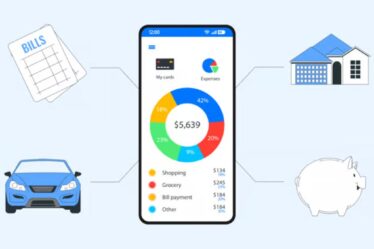Have you ever felt like the world of investing is like a maze with no way out? Discover how I found my financial path with the best investment apps that transformed my economy.
My Financial Awakening: From Beginner to Digital Investor
I remember that Monday morning perfectly.
Coffee in hand, reviewing my bank account and facing the harsh reality: my money was losing value while remaining static in my savings account.
Inflation was doing its job and I, at 32 years old, still couldn't take control of my financial future.
“What if I start investing?” I asked myself. But doubts immediately came to mind: How do I start? Do I need a lot of money? What if I lose everything? The fear of the unknown paralyzed me.
It was then that a friend told me about the investment apps. “They’re like having a financial advisor in your pocket,” he told me. Skeptical but curious, I decided to give them a try. And how they changed my life.
So, after three years of using different platforms, testing features and, yes, making some costly mistakes, today I want to share my journey through best investment apps available in 2025.
The apps that revolutionized my way of investing
Robinhood: My first experience in the investing world
When I started my journey into the world of investing, Robinhood was my first stop.
What attracted me most was its clean and simple interface. As a beginner, the last hurdle I needed was to face an app that looked like an airplane control panel.
Advantages I discovered:
- Zero commissions on basic operations (a relief for my small starting capital!)
- Incredibly simple registration process
- The “Learn” function helped me understand basic concepts
My stumbles:
- I felt limited when I wanted to access deeper analysis
- Diversification tools are somewhat basic
One afternoon in February, with just US$100, I made my first investment in a technology company's stock.
The feeling of “owning” a small piece of this company was addictive. For a beginner like me, Robinhood delivered perfectly.
Personal advice: If you are an absolute beginner, start here, but don't just stick with this platform once you start growing.
Fidelity: When I decided to get serious with my money
Six months after my first steps, I felt like I needed more tools. Then a coworker recommended Fidelity to me, and I discovered a whole new world.
What won me over:
- Deep research tools (I spent entire nights analyzing charts!)
- Retirement Planning Options That Made Me Think Long-Term
- Outstanding customer service (they helped me via video call when I had questions)
My frustrations:
- The learning curve was steep; I felt overwhelmed the first few weeks
- The mobile app sometimes felt less intuitive than the web version
With Fidelity, I understood the importance of diversification. I stopped focusing solely on individual stocks and started exploring ETFs and mutual funds.
My portfolio started to behave more stably, even on volatile market days.
Wealthfront: The Discovery That Automated My Strategy
There came a time when my workload intensified. Travel, projects, and deadlines left me little time to actively manage my investments.
It was then that I discovered Wealthfront and its automated investment proposal.
What transformed my experience:
- Initial setup based on my risk profile (I answered a questionnaire and the app did the rest)
- Automatic rebalancing of my portfolio without me having to do anything
- Tax-loss harvesting helped me optimize taxes
Aspects that can be improved:
- Less direct control over specific investments
- Commissions, although low (0.25%), add up over time
One night, while reviewing my quarterly returns, I realized something surprising: my automated investments on Wealthfront were outperforming the ones I managed manually on other platforms. It was a humbling experience that made me rethink my strategy.
eToro: The social dimension that changed my perspective
My curiosity led me to eToro, and it was like joining a social network for investing. Plus, the idea of being able to see what other investors were doing and even copy their strategies seemed revolutionary to me.
My biggest discoveries:
- Copying the strategies of experienced investors has opened up new perspectives for me
- The news and commentary feed kept me informed about market movements
- The community answered questions that they didn't even know they had
What didn't fully convince me:
- Some hidden commissions I discovered late
- The social component sometimes generates “noise” and can lead to impulsive decisions
I remember one October afternoon when, following an investor specializing in renewable energy, I diversified my portfolio just before a major rally in the sector.
It was then that I understood the value of collective intelligence in investments.
Public: Transparency and education that won me over
The latest addition to my investment app arsenal is Public. I was drawn to its approach to transparency and educational component.
What enchanted me:
- Investment themes that group stocks by trends or sectors
- Educational events and webinars that increased my knowledge
- No payment for order flow, a more transparent model
Aspects to improve:
- Fewer advanced options for complex operations
- Technical analysis somewhat limited for intermediate investors
At Public I discovered thematic investments that I hadn’t even considered, such as water savings or cybersecurity.
This helped me diversify my portfolio into emerging sectors with long-term growth potential.
My Strategies for Maximizing Every Investment App
Over the years, I have developed some strategies that have helped me make the most of these investment apps. Maybe they can help you:
1. Distribute capital according to strengths
I don’t put all my money in one app. I use Wealthfront for my long-term “serious money,” Robinhood for occasional quick trades, and eToro to explore new investment ideas.
2. Take advantage of educational tools
I dedicate at least an hour a week to the educational resources on these platforms. Additionally, Public’s webinars and Fidelity’s articles have been particularly valuable to my growth as an investor.
3. Set clear boundaries
After some painful losses from impulsive decisions, I set myself strict rules: I never invest more than 5% of my capital in “high risk” ideas and I have a fixed monthly budget for investments.
4. Use price alerts
In all the apps that allow it, I set up price alerts. They have saved me from missing out on buying opportunities during momentary market drops.
5. Review commissions regularly
Every three months I analyze how much I'm paying in commissions on each platform. Sometimes I've been surprised to discover hidden costs that I hadn't noticed.
The mistakes I made (so you don't repeat them)
My path has not been free of setbacks. These are the most costly mistakes I have made with investment apps:
Error #1: Obsessing over reviewing my portfolio daily
During my first few months, I reviewed my investments several times a day. Each fluctuation caused me anxiety and led me to make rash decisions. Then I learned that for long-term investments, reviewing once a week is more than enough.
Error #2: Not understanding the tax implications
In my first year as an investor I had an unpleasant surprise during the trading season. taxes. I hadn't considered how my earnings would be taxed. Now I use Wealthfront's tax planning tools and it has saved me a lot of headaches.
Error #3: Copying strategies without understanding them
On eToro, I started copying high-yielding investors without really understanding their strategies. When the market turned, I suffered losses because I didn't know when to adjust course.
Error #4: Ignoring small commissions
I thought that commissions of 0.25% or 0.5% were insignificant. Over time, I realized that over large amounts and long periods, they represent thousands of dollars of difference in the final return.
Which investment app is right for you?
Finally, after my experience, I came to some conclusions about which platform could best adapt to different profiles:
For absolute beginners:
Robinhood or Public – Intuitive interfaces, low barrier to entry and good educational resources.
For investors looking for automation:
Wealthfront or Betterment – Passive management with automatic rebalancing and tax-efficient strategies.
For those seeking in-depth analysis:
Fidelity or TD Ameritrade – Advanced research tools and wide range of financial products.
For investors interested in the social aspect:
eToro or Public – Social components that allow learning from others and sharing ideas.
For international investments:
Interactive Brokers – Access to global markets with competitive commissions.
My current strategy: a hybrid approach
Currently, my strategy is based on a hybrid approach that combines the best of several investment apps:
- 70% in automated investments through Wealthfront, focused on low-cost ETFs and global diversification.
- 20% in actively managed investments at Fidelity, where I select individual stocks and specific sectors.
- 10% in exploratory investments using eToro and Public, testing new ideas and following interesting investors.
This distribution has allowed me to maintain consistent growth while continuing to learn and explore new opportunities.
The journey is just beginning
My experience with the best investment apps transformed not only my financial situation, but my mindset about money.
So I went from seeing savings as something static to understanding that my capital can and should work for me.
If you are just starting out, then I encourage you to get started. Start small, learn constantly, and don’t be afraid to make mistakes.
Furthermore, the applications I mentioned have democratized access to investments, eliminating barriers that previously seemed insurmountable.
Have you ever used any of these platforms? Or do you know of any others that deserve to be on this list? I'd love to hear your experience in the comments.
Finally, if this article was useful to you, share it with friends who could also benefit from taking the leap into the world of digital investments.
Remember: This is my personal experience. So before making any financial decisions, do your own research and consider consulting a certified financial advisor.
RELATED CONTENT

Income tax declaration application
I discovered an app for filing income taxes that transformed...
Read more →
Caixa Tem: everything you need to know
I arrived in Brazil (with controversy)! If there is an application that has...
Read more →
She’s practically an app detective—she tests, explores, tries out and gives us her honest opinion on each app. A technology addict and a review “expert,” she separates the apps that are pure hype from those that really make a difference. If there’s something new in the tech world, you can bet she’s already tried it before anyone else!




